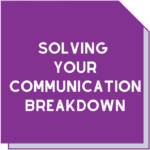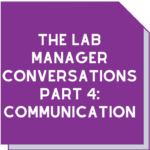Navigating the 7 Cs of communication
 Every day we need to communicate. And whether it’s grunts from teenagers or the long, winding conversations we have with old friends, we also need to interpret what’s being said.
Every day we need to communicate. And whether it’s grunts from teenagers or the long, winding conversations we have with old friends, we also need to interpret what’s being said.
Effective communication in the workplace is critical. Management is often judged by the quality of communications with the rest of the organisation. Teams judge their leaders in the same way. And no doubt, you form opinions about colleagues based on your interactions. We’ve written previously about what can happen if there’s a communication breakdown.
The 7 Cs of Communication were introduced by Scott M. Cutlip and Allen H . Center in their textbook ‘Effective Public Relations’. First published in 1952, the list was developed to help improve professional communication skills in the advertising industry.
Various versions of this list have since been used in books and training courses on business, marketing, and communication. However, the core purpose of the list remains the same: to increase the chances of the message that’s being conveyed being received as it was intended.
During lockdowns, a lot of our communication took place via email or over a screen. So in theory, we should all be terrific at communicating! But if you need to up your communication game, these are valuable hints for you to consider.
What are the 7 Cs?
There may have been some additions to the list since they were originally published but the primary ones are:
- Clarity
- Correctness
- Conciseness
- Courtesy
- Concreteness
- Consideration
- Completeness
While these seem simple enough, we’ve all been in meetings or received emails that have left us scratching our heads. Let’s look at each of these in a little more detail.
Clarity
 If you’ve ever read an ISO standard, you’ll relate to this one!
If you’ve ever read an ISO standard, you’ll relate to this one!
Whether it’s an email or a presentation, trying to cram too many ideas into a paragraph at once is going to lead to confusion. Even worse is cramming multiple points into a single sentence.
Be clear about the goal of your message. Emphasise one specific idea at a time – using shorter sentences can help. Use unambiguous and concrete words to ensure your message is clearly understood.
If your communication is within your organisation, you can use acronyms such as SOP. However, if your communication is likely to go to external parties, spelling out Standard Operating Practice is a better choice.
And be sure to use language that is easily understood. Using ‘vicissitudes’ in a sentence may make you sound smart but ‘variations’ will be better understood by your audience.
Correctness
This may sound silly but before you hit send, it’s best to be certain – are you passing on the right information? And to the right person?
If you’re using facts and figures, ensure you’re using the correct ones.
For example, if you’re sending someone a copy of a test report, are you certain it’s the report for their business? If you’ve done a ‘save as’ for a client’s Excel spreadsheet to save time, have you removed the name and data from the previous client? Such errors can cause the loss of another ‘C’ – credibility. And can mean you breach another ‘C’ that’s not in the 7 C’s: confidentiality.
Does your message contain spelling errors? Proofread your work and remember, spell check is everyone’s friend here. Typing ‘herd’ instead of ‘heard’ may be amusing but could also be confusing for your recipient. It can also help with grammatical errors so do run it before you send.
Conciseness
 We’ve all been in meetings that could have been an email!
We’ve all been in meetings that could have been an email!
You need to pass on the message but try to do this in the most succinct way possible. By using the fewest number of words necessary to convey your message, you’ll keep the reader’s attention.
For example: ‘We have been considering the existing policies we have for our human resources department, including those strategies we have in place for hiring of new staff, and in light of these considerations, we have updated that particular policy’.
Instead: ‘Our hiring policy has been updated because our existing strategies were ineffective’.
Focus on the key points and don’t add random facts that will confuse the recipient. However, that doesn’t mean you should skimp on relevant details. Give your audience all the facts they need to make an informed decision.
Courtesy
A tersely worded email could mean you’re in a hurry and wanted to send it before you left for the day. But for the recipient, this message could come across in a completely different way.
Be polite, friendly, and positive. Read your message before you send. Is the language you’ve used respectful? How would you feel if you received that message?
Many businesses have implemented fair and inclusive work practices and policies. Ensure you are not breaching these by using discriminatory or inappropriate language in your communications.
Concreteness
Concrete communication isn’t vague or wishy washy. Ensure your message is not open to misinterpretation and aim to use active voice. Being specific is the key here.
If you’ve quoted facts and figures, ensure these are relevant and confirm the point you’re trying to make.
Telling a sales team that they haven’t hit their target is less effective than saying ‘Your monthly sales target was $20,000 but your actual sales were $15,000’.
Consideration
Think about the audience for your piece of communication. Consider their education, experience, and attitudes. Is your message geared towards their thinking?
Keep in mind that perhaps not everyone needs to receive your communications. We receive multiple daily messages so ensure that everyone on your address list needs to be there.
And be very careful with the ‘reply all’ email function!
Completeness
 Does the message contain everything the recipient needs to understand what you’re trying to communicate? Do they have all the facts needed to make an educated decision?
Does the message contain everything the recipient needs to understand what you’re trying to communicate? Do they have all the facts needed to make an educated decision?
Ensure you answer what, when, why, who, where and how. For example, saying ‘You have yet to complete the task I set you’ is extremely unhelpful.
However, ‘I don’t have the test results I asked for on 6 October which should have been completed today. Will you have this finished this afternoon?’ is extremely clear and lays out your expectations.
The final word
We communicate every day, with varying degrees of success. However, the 7 Cs provide the basis for being an effective communicator. And they’re simple enough for you to implement immediately.
If you don’t want to leave people wondering what the point of your last email was, try using the 7 Cs!
And of course, if you’re having difficulty communicating with say, your accreditation body, we’re here to help. Phone Maree (0411 540 709), Diane (0402 012 781) or email info@masmangementsystems.com.au
Remember, you don’t have to do this alone!
Download the article Navigating the Cs of communication






